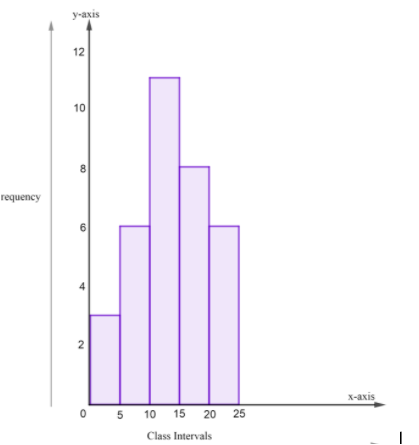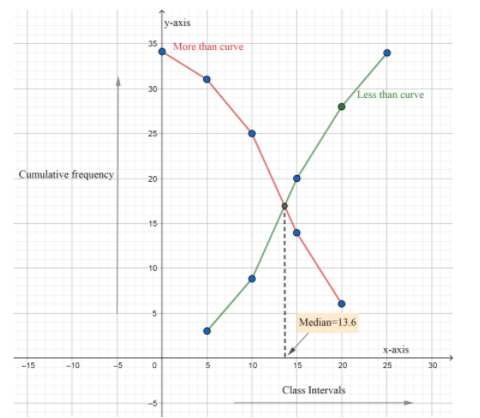
Find median of the following grouped data graphically?
Class Interval Frequency 0-5 03 5-10 06 10-15 11 15-20 08 20-25 06
| Class Interval | Frequency |
| 0-5 | 03 |
| 5-10 | 06 |
| 10-15 | 11 |
| 15-20 | 08 |
| 20-25 | 06 |
Answer
567k+ views
Hint: First we will write the definition of the median in general and then we will write the given data and then we will make a more than curve and a less than curve by first making a more than cumulative frequency table and a less than cumulative frequency table, finally we will plot the obtained points and then where the two points intersect that will be our median.
Complete step by step answer:
First let’s understand the meaning of the median of a given data, so median is the middle value of the given set of data when arranged in a particular order. Now, if the number of observations in any given data is odd, therefore the median will be ${{\left( \dfrac{n+1}{2} \right)}^{th}}$term, whereas when the number of observations is even then the median will be both ${{\left( \dfrac{n}{2} \right)}^{th}}\text{ and }{{\left( \dfrac{n}{2}+1 \right)}^{th}}$ observations.
So, let’s consider the data given to us:
Graphical representation for above data will look like the following figure:

Similarly, we will form less than cumulative frequency table, that means we will take the upper limit of every class and see what is the total frequency present before that, which will be our cumulative frequency:
We will now plot these cumulative frequencies on a graph and form a more than curve and a less than curve and we know that the point where more than and less than curves meet then that will be our median.

As, we see from the graph that more than and less than curve meets at 13.6 therefore, the median is 13.6
Note: Since, it is a grouped data conventional formula for median is not applied. For calculating the median of a grouped data, following formula is applied:
$\text{Median}=L+\dfrac{\left( \dfrac{n}{2} \right)-B}{G}\times w$
Where, L is the lower class boundary of the group containing the median, n is the total number of values, B is the cumulative frequency of the groups before the median group, G is the frequency of the median group and w is the group width.
Complete step by step answer:
First let’s understand the meaning of the median of a given data, so median is the middle value of the given set of data when arranged in a particular order. Now, if the number of observations in any given data is odd, therefore the median will be ${{\left( \dfrac{n+1}{2} \right)}^{th}}$term, whereas when the number of observations is even then the median will be both ${{\left( \dfrac{n}{2} \right)}^{th}}\text{ and }{{\left( \dfrac{n}{2}+1 \right)}^{th}}$ observations.
So, let’s consider the data given to us:
| Class Interval | Frequency |
| 0-5 | 03 |
| 5-10 | 06 |
| 10-15 | 11 |
| 15-20 | 08 |
| 20-25 | 06 |
Graphical representation for above data will look like the following figure:

Similarly, we will form less than cumulative frequency table, that means we will take the upper limit of every class and see what is the total frequency present before that, which will be our cumulative frequency:
| Class Interval | Cumulative Frequency |
| Less than 5 | 3 |
| Less than 10 | 9 |
| Less than 15 | 20 |
| Less than 20 | 28 |
| Less than 25 | 34 |
We will now plot these cumulative frequencies on a graph and form a more than curve and a less than curve and we know that the point where more than and less than curves meet then that will be our median.

As, we see from the graph that more than and less than curve meets at 13.6 therefore, the median is 13.6
Note: Since, it is a grouped data conventional formula for median is not applied. For calculating the median of a grouped data, following formula is applied:
$\text{Median}=L+\dfrac{\left( \dfrac{n}{2} \right)-B}{G}\times w$
Where, L is the lower class boundary of the group containing the median, n is the total number of values, B is the cumulative frequency of the groups before the median group, G is the frequency of the median group and w is the group width.
Recently Updated Pages
A man running at a speed 5 ms is viewed in the side class 12 physics CBSE

The number of solutions in x in 02pi for which sqrt class 12 maths CBSE

State and explain Hardy Weinbergs Principle class 12 biology CBSE

Write any two methods of preparation of phenol Give class 12 chemistry CBSE

Which of the following statements is wrong a Amnion class 12 biology CBSE

Differentiate between action potential and resting class 12 biology CBSE

Trending doubts
What are the major means of transport Explain each class 12 social science CBSE

Which are the Top 10 Largest Countries of the World?

Draw a labelled sketch of the human eye class 12 physics CBSE

How much time does it take to bleed after eating p class 12 biology CBSE

Explain sex determination in humans with line diag class 12 biology CBSE

When was the first election held in India a 194748 class 12 sst CBSE




